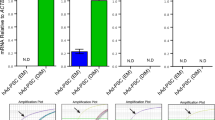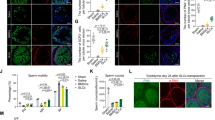Abstract
Transplantation of neural tissue into the mammalian central nervous system has become an alternative treatment for neurodegenerative disorders such as Parkinson's disease. Logistical and ethical problems in the clinical use of human fetal neural grafts as a source of dopamine for Parkinson's disease patients has hastened a search for successful ways to use animal dopaminergic cells for human transplantation. The present study demonstrates that transplanted testis-derived Sertoli cells into adult rat brains survive. Furthermore, when cotransplanted with bovine adrenal chromaffin cells (xenograft), Sertoli cells produce localized immunoprotection, suppress microglial response and allow the bovine cells to survive in the rat brain without continuous systemic immunosuppressive drugs. These novel features support Sertoli cells as a viable graft source for facilitating the use of xenotransplantation for Parkinson's disease and suggest their use as facilitators (i.e., localized immunosuppression) for cell transplantation in general.
This is a preview of subscription content, access via your institution
Access options
Subscribe to this journal
Receive 12 print issues and online access
$209.00 per year
only $17.42 per issue
Buy this article
- Purchase on Springer Link
- Instant access to full article PDF
Prices may be subject to local taxes which are calculated during checkout
Similar content being viewed by others
References
Bjorklund, A., Stenevi, U., Dunnett, S.B. and Gage, F.H. 1982. Cross-species neural grafting in a rat model of Parkinson's disease. Nature 298: 652–654.
Bjorklund, A. and Stenevi, U. 1985. Intracerebral neural grafting: A historical perspective, pp. 3–14 in Neural Grafting in the Mammalian CNS. Bjorklund, A. and Stenevi, U. (eds.). Elsevier, Amsterdam.
Lindvall, O., Backlund, E.D., Farde, L., Sedvall, G., Freedman, R., Hoffer, B. et al. 1987. Transplantation in Parkinson's disease: two cases of adrenal medullary grafts to the putamen. Ann. Neurol. 22: 457–468.
Mayer, E., Fawcett, J.W. and Dunnett, S.B. 1993. Basic fibroblast growth factor promotes the survival of embryonic ventral mesencephalic dopaminergic neurons—II. effects on nigral transplants in vivo. Neuroscience 5: 389–398.
Hedger, M.P. 1989. The testis: An ‘immunologically suppressed’ tissue? Reprod. Fertil. Dev. 1: 75–81.
Skinner, M.K. 1993. Secretion of growth factors and other regulatory factors, pp. 237–248 in The Sertoli Cell. Rusell, L.D. and Griswold, M.D. (eds.). Cache River Press, Clearwater, FL.
Bellgrau, D., Gold, D., Selawry, H., Moore, J., Franzusoff, A. and Duke, R.C. 1995. A role for CD-95 ligand in preventing graft rejection. Nature 377: 630–632.
Selawry, H.P. and Cameron, D.F. 1993. Sertoli cell-enriched fractions in a successful islet cell transplantation. Cell Transplant. 2: 123–129.
Barker, C.F. and Billingham, R.E. 1977. Immunologically privileged sites. Adv. Immunol. 25: 1–54.
Widner, H. and Brundin, P. 1988. Immunological aspects of grafting in the mammalian central nervous system. A review and speculative synthesis. Brain Res. Rev. 13: 287–324.
Finsen, B.R., Sorensen, T., Gonzalez, B., Castellano, B. and Zimmer, J. 1991. Immunological reactions to neural grafts in the central nervous system. Restor. Neurol. Neurosci. 2: 271–282.
Sagen, J., Wang, H., Tresco, P.A. and Aebischer, P. 1993. Transplants of immunologically isolated xenogeneic chromaffin cells provide a long-term source of pain-reducing neuroactive substances. J. Neurosci. 13: 2415–2423.
Finsen, B., Poulson, P.M. and Zimmer, J. 1988. Xenografting of fetal mouse hippocampal tissue to the brain of adult rats: effects of cyclosporin A treatment. Exp. Brain Res. 70: 117–133.
Brundin, P., Widner, H., Nilsson, O.G., Strecker, R.B. and Bjorklund, A. 1989. Intracerebral xenografts of dopamine neurons: The role of immunosuppression and the blood-brain barrier. Exp. Brain Res. 75: 195–207.
Berden, J.H.M., Hoitsma, A.J., Merx, J.L. and Keyser, A. 1985. Severe central nervous system toxicity associated with cyclosporine. Lancet 26: 219–220.
de Groen, C., Aksamit, A.J., Rakela, J., Forbes, G.S. and Krom, R.A.F. 1984. Central nervous system toxicity after liver transplantation. New England J. Med. 317: 861–866.
Emerich, D.F., Winn, S.R., Christenson, L., Palmatier, M.A., Gentile, F.T. and Sanberg, P.R. 1992. A novel approach to neural transplantation in Parkinson's disease: Use of polymer-encapsulated cell therapy. Neurosci. Biobohav. Rev. 16: 437–447.
Lysaght, M.J., Frydel, B., Gentile, F., Emerich, D.F. and Winn, S. 1994. Recent progress in immunoisolated cell therapy. J. Cell. Biochem. 56: 196–203.
Freeman, T.B., Sanberg, P.R., Nauert, G.N., Boss, B.D., Spector, D., Olanow, C.W. and Kordower, J.H. 1995. The influence of donor age on the survival of solid and suspension intraparenchymal human embryonic nigral grafts. Cell Transplantation 4: 141–154.
Ortega, J.D., Sagen, J. and Pappas, G.D. 1992. Survival and integration of bovine chromaffin cells transplanted into rat central nervous system without exogenous trophic factors. J. Comp. Neurol. 323: 1–12.
Paxinos, G. and Watson, C. 1982. The Rat Brain in Stereotaxic Coordinates. Academic Press, NY.
Streit, W.J. 1990. An improved method for rat microglial cells using the lectin from Griffonia simplicifolia (GSAI-B4). J. Histochem. Cytochem. 11: 1683–1686.
Author information
Authors and Affiliations
Rights and permissions
About this article
Cite this article
Sanberg, P., Borlongan, C., Saporta, S. et al. Testis-derived Sertoli cells survive and provide localized immunoprotection for xenografts in rat brain. Nat Biotechnol 14, 1692–1695 (1996). https://doi.org/10.1038/nbt1296-1692
Received:
Accepted:
Issue Date:
DOI: https://doi.org/10.1038/nbt1296-1692
This article is cited by
-
Role of indoleamine 2,3-dioxygenase in testicular immune-privilege
Scientific Reports (2019)
-
Sertoli Cells Avert Neuroinflammation-Induced Cell Death and Improve Motor Function and Striatal Atrophy in Rat Model of Huntington Disease
Journal of Molecular Neuroscience (2018)
-
Therapeutic Potential of Pretreatment with Allograft Sertoli Cells Transplantation in Brain Ischemia by Improving Oxidative Defenses
Journal of Molecular Neuroscience (2018)
-
Coenzyme Q10 Prevents Mitochondrial Dysfunction and Facilitates Pharmacological Activity of Atorvastatin in 6-OHDA Induced Dopaminergic Toxicity in Rats
Neurotoxicity Research (2017)
-
Long-term culture and significant expansion of human Sertoli cells whilst maintaining stable global phenotype and AKT and SMAD1/5 activation
Cell Communication and Signaling (2015)



